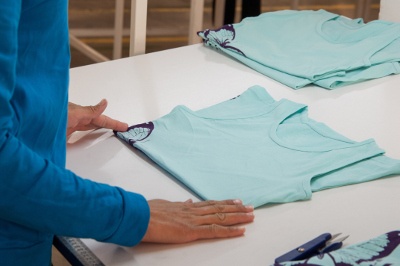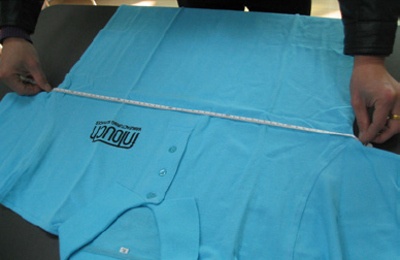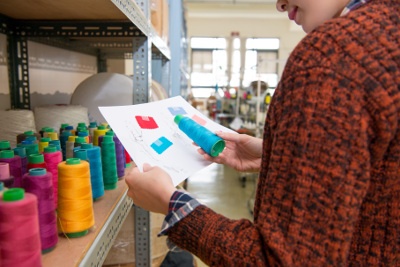 With greater competition than ever before, garment importers are under strict time crunches to deliver products within a short time window. So how do they meet tight shipping deadlines and still deliver a quality product?
With greater competition than ever before, garment importers are under strict time crunches to deliver products within a short time window. So how do they meet tight shipping deadlines and still deliver a quality product?
Pre-shipment inspection is still one of the best ways to manage product quality. Only by seeing the goods before they leave the factory can you be confident in the quality of what you’ll receive. And like many garment importers, you may be considering turning to third-party inspection to monitor product quality in a time-efficient manner (related: How Betabrand Limits Quality Defects to Delight Their Garment Buyers [Case Study]).
For garment importers that don’t have full-time QC staff in Asia, it’s possible to rely on factory QC staff or to personally travel to factories to conduct inspection yourself (related: What are the Best Options for Quality Control Inspection for Garments?). But the efficiency and accuracy of third-party inspections and reporting often provide the best value for garment importers.
Let’s look at popular reasons for hiring a third-party QC provider and what main advantages there are over alternative inspection methods.
1. Fast reporting to help you address problems immediately
When you’re based in a different time zone than your supplier it can take longer than expected to sort out details following an inspection. Receiving a detailed report of any quality issues quickly helps you address problems with minimal production or shipping delays. Aside from issuing their report within 24 hours of inspection, most third-party inspection companies operate efficiently to help you budget your time.
How acceptance sampling makes garment inspection more efficient
Most third-party inspection companies use acceptance sampling methods like AQL to pull a statistically-significant number of garments for inspection at the factory (related: Why QC Professionals Use AQL Sampling for Product Inspection). This allows for most inspections to be completed in a much shorter amount of time than is often needed to inspect 100 percent of an order. Sampling also keeps the cost of inspection lower, since most third-party inspection companies will bill you based on time.
Using a standardized system like AQL means you can usually trust the pass or fail result of the inspection to reflect your quality standards (related: How AQL Sampling Affects Your Product Inspection Results). Inspectors systematically categorize defects based on severity and determine an acceptable number of defects for your lot size.
By setting an inspection level ahead of inspection and clearly specifying requirements, you can avoid misinterpretation by inspectors and ensure that the report they issue accurately reflects your standards.
Budgeting enough time to understand and address defects
A comprehensive report should usually provide all the information you need to make a shipping decision, including detailed remarks, photos, measurements, on-site testing results and more. However, there might be some pending remarks which you need to clarify with your contact at your inspection company. The earlier you receive your inspection report, the less likely you’ll need to rush and risk making an ill-informed decision about how to proceed.
Aside from allowing time to review the report and address any issues found, you might also want to budget time to review defective goods yourself. Your inspector can seal a sample at the factory and send it to your office for review. While most garment importers may not need this level of oversight, garment importers selling goods at a high price point might find it useful. This is especially true for issues with the fabric quality that may only be apparent by hand feel alone.
If the type or number of defects in your order is unacceptable, it’s up to you, as the customer, to decide how to proceed with the goods. For example, you might ask your supplier to rework or replace defective goods before shipping, if feasible. You and your supplier would need to allow time for factory rework, and potentially re-inspection to confirm rework, before shipping.
2. Detailed garment measurements to assure proper fitting
Proper fit is arguably the most important factor in a consumer’s decision to purchase a garment. While a garment may look appealing on the rack, many customers won’t buy an item of clothing without trying it on first to confirm the fit.  Third-party inspection for garments should include special attention to size and fit requirements to ensure customers don’t return your garments in mass (related: 5 Essential Garment Inspection Steps to Protect Your Quality).
Third-party inspection for garments should include special attention to size and fit requirements to ensure customers don’t return your garments in mass (related: 5 Essential Garment Inspection Steps to Protect Your Quality).
Reporting garment dimensions out of tolerance
Every quality control inspection for garments should include detailed measurements of your dimension specifications (related: 3 Key Areas of Quality Control for Garments). And you’ll want to confirm your measuring method with your inspectors beforehand, even if they have extensive garment QC experience.
But reporting on dimensions and fit is not as simple as just checking every point of measurement for the garment. Manufacturing garments is a highly labor-intensive process. It’s unlikely that every garment will be exactly the same size down to the millimeter. Provide your QC team with a range of tolerances allowed for comparing with the actual measurement. Inspectors will use this conformance to dimensional tolerances, along with your other criteria, to determine the pass or fail result of inspection.
It’s also standard practice for third-party inspectors to use a mannequin to assess proper garment fit. For example, a spaghetti strap tank top might appear normal when simply placed on an inspection table. But when the garment is put on the mannequin, the straps may not be completely parallel, offsetting the fit of the garment. Your inspection report should include photos of your garment on a mannequin to help you visualize how it will appear on your customers.
3. Reporting production status to help you meet deadlines
Suppliers aren’t always responsive or transparent regarding customers’ requests to keep them updated on their production schedule. Suppliers typically balance a number of orders at the same time and can easily make excuses or delay your order without informing you. Third-party inspection performed at different stages helps you ensure production is on track.
Most third-party inspection companies can conduct quality control inspection for garments at any time before, during or after mass production, including:
- Pre-production inspection, or incoming quality control (IQC), verifying raw fabrics and materials
- During production (DUPRO) inspection conducted when 15-80 percent of the total order quantity is finished
- Final inspection conducted when at least 80 percent of goods are finished and packed
You might also choose to inspect a first article or monitor container loading just before shipping. The above three inspection types represent the most common stages to inspect. Each offers unique insight and advantages related to understanding production status and quality.
Limit shipping delays by catching and addressing issues earlier in production
There are some garment defects that take relatively more time to address, like a hole in the garment or shade differences in the fabric color among units. Factory staff may be unable to fix these kinds of issues by reworking or repairing the goods. Instead, the factory may need to produce new units to replace those defective. And if there’s shade variation in the raw fabric used in the production of the garment, the factory may also have order new fabric from their supplier to match the specified fabric color.
If you rely on final inspection to identify defects, the factory will have finished production on all, or almost all, of your garments by the time you’re aware of any issues. But you’d likely be able to catch any problems before they affect a majority of your products by conducting an earlier DUPRO inspection. This often saves importers time by allowing them to address a smaller issue before it balloons into a larger one closer to their shipping deadline.
4. Third-party inspection helps hold your suppliers accountable
Aside from identifying quality issues, inspection can actually dissuade a garment factory from manufacturing substandard products. This is because suppliers are less likely to cut corners on an order when they know that an independent, third-party inspector will be checking the goods and reporting to their customer before shipping.
Always inform your supplier upfront about any expectations for pre-shipment inspection. It’s best to include these expectations prominently in your purchase order. You should indicate who will conduct the inspection, give an introduction to the third-party inspection company and establish when the order will be inspected. This will minimize any pushback or resistance to inspection from your supplier later, should they try to argue they weren’t given sufficient advance notice.
“Quality fade” in garments over time
You might think that after you’ve built a relationship with a supplier following multiple orders, you no longer need to conduct inspections. With plenty of attention paid to fostering your supplier relationship, you might be able to gradually reduce your need for inspections over time. But most garment importers find that inspection remains a necessary step to hold their factory accountable to their requirements and avoid a common problem known as “quality fade”.
Quality fade is a gradual decrease in product quality which typically happens as importers become comfortable working with a given supplier. Often the factory begins with minor, subtle cost reductions affecting the quality of raw materials or components. For example, workers might use a cheaper material to line the pockets of your garments. The change might not be immediately noticeable, but later becomes apparent when it tears easily during normal use.
A third-party QC provider can help you prevent or eliminate quality fade by:
- Helping you develop and maintain a detailed and current quality control checklist for your product with objective and measureable product requirements; and
- Inspecting the goods before shipping to verify the supplier is maintaining an acceptable level of quality from one production run to the next
Quality fade typically catches garment importers off guard when they curtail their level of QC oversight. Staying vigilant with clear requirements and periodic inspection from a third-party are often very effective measures for preventing it.
5. Advantages of third-party inspection over other types of garment inspection
Third-party inspection isn’t your only option for inspecting garments (related: 4 Ways Importers Conduct Product Inspection [eBook]). You should always consider other available options for managing product quality with inspection, including:
- Relying on factory QC staff for product inspection
- Hiring full-time inspectors based locally for inspection
- Personally travelling to the factory to inspect the goods yourself; and
- Hiring a third-party inspection company to inspect on your behalf
One of the biggest advantages of third-party inspection is cost. Third-party inspection companies often have inspectors based locally in major garment manufacturing centers throughout their coverage area, which helps control costs related to traveling to inspection sites. The result is that hiring a third party is typically more cost effective and efficient than travelling on your own to the factory or hiring full-time inspectors, especially if you’re a smaller or medium-sized garment importer.
Putting your interests first
The major benefit of third-party inspection, as opposed to relying on factory staff to inspect, is that third-party inspectors are far more likely to issue an unbiased report. Since they’re independently hired by you, you can be more confident that they have your best interests in mind. Whereas internal QC staff are employed by the supplier and have reason to issue a favorable report of quality, if they issue a report to you at all.
Putting your interests first also means maintaining high integrity. And most third-party inspection companies proactively avoid integrity issues by rotating inspectors regularly to prevent staff from developing close, personal relationships with factory staff that might affect their judgement. Third-party inspection companies also typically enforce a Code of Ethics and require specific documentation, such as a Factory Integrity Declaration Form, to prevent misconduct in the field.
Measures like these help ensure that you know the true situation and status of your garments at your supplier’s facility.
Conclusion
You might be reluctant to place the quality of your garments in the hands of an unfamiliar third-party inspection company. But third-party QC partners are able to customize inspections based on your specific needs to ensure your products meet your quality standards. You might consider setting detailed inspection procedures and adjust the scope of your inspections to better meet your needs.
And if you provide the inspection company with feedback on inspection reports, they can usually adjust the reporting and way of classifying quality issues. By consistently providing input, your report will become more accurate with time. And you’ll receive the product quality your customers expect without ever having to set foot inside the factory yourself!
What are some reasons why you choose not to use third-party inspection for your garments? Share your thoughts in the comments section below!







